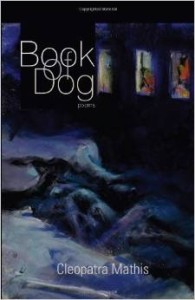Cleopatra Mathis. Book of Dog. Sarabande Books, 2012. 69 pgs. $14.95.
Reviewed by Lynn Domina
At first glance, Book of Dog by Cleopatra Mathis does not seem particularly unusual. It’s arranged into three sections, the poems mostly shorter than a page and mostly justified left. Although taken together, the poems imply a narrative, taken individually they read as lyrics, focused on the speaker’s perceptions of the moment, an aesthetic inclination common to much contemporary American poetry. In other ways, however, particularly tone and content, the collection is unlike most others I’ve read. The first section of the collection, “Canis,” focuses on the dissolution of a marriage, revealed more through the geographic context of the human characters than through their actual interactions. The second section, “Book of Dog,” is a thirteen-part sequence narrating and grieving the death of a dog. The final section, “Essential Tremor,” opens further outward, describing the lives of other creatures and the speaker’s relationships with them. In this book, Cleopatra Mathis is a nature poet, but her approach is her own. The poems are neither as romantic as Mary Oliver’s often are nor as scientifically precise as those of Pattiann Rogers; nature doesn’t serve here primarily as an avenue to epiphany, nor is it the means to an interesting description. (And lest I be misinterpreted, I admire the work of both Oliver and Rogers.) Instead the poems explore encounters between the speaker and the other life forms, more fully dependent on the speaker’s personality than many nature poems are. Mathis participates in a tradition, in other words, but she makes it her own.
In the first section, the characters are often identified simply as “he” and “she.” As often occurs when relationships dissolve, neither character is particularly admirable, the “he” withdrawn and silent, the “she” resentful and accommodating. Fortunately, the poems’ attention to the sound of language and the imagery, especially as it describes the world beyond the couple, keep us reading. My favorite poem in this section, “Song of If-Only,” is stylistically unusual, though thematically linked to the others. It conveys the obsessiveness of hindsight and regret, while acknowledging the futility and irritation of both. Here is its opening sentence:
If only the bird had been alive, not something dead
delivered onto sand; and not this packed cold sand,
where nothing moves even slightly, no blow-holes,
no scurrying things, and if only the shore birds’
seaweed nests, that little piping, hadn’t been smothered
by a freak spring tide.
That’s how regret works: if only this, if only that. The sounds of this sentence attract me—the alliteration, “dead / delivered”; the assonance, “sand…packed…sand” and “no blow-holes”; the rhythmic shift between the hard “packed cold sand” and the softer “shore birds’ / seaweed nests.” The speaker continues, introducing a bit of humor and hyperbole: “O save me” and “Euphoria / just the name of the shack I want in this driving rain.” Finally, the poem concludes with self-awareness, an acknowledgement that thought patterns can retain their hold over us even when we understand their ineffectiveness:
And if only it would stop, shut itself up for good—
this off-key if only that goes on singing,
like some deranged child, repeating.
I will not discuss any of the poems in the second section at length, although they are central to the collection’s themes. My neglect of them is perhaps unfortunate for that reason, and also because the speaker’s extended close attention to a companion animal (as opposed to wilder species) is unusual. This section is best read in its entirety, however, and so I will leave it to each reader to do so.
The tightest poems in the book occur in the last section, and they are nicely balanced between imagery and interpretation. In “Magnet” the language is attractive even when the imagery disturbs:
The ocean’s fickle, especially when it’s cold June
and the packrat bands of ducks and gulls,
all the worse for their nipping and wailing, force themselves
on trash and more trash the winter tides kept hoisting up.
Humanity enters this poem only through its residue, the “trash”: “the fishing line hung from the gull’s mouth / and the ribboned balloon wound itself tight / around the dead seal’s neck…” The trash is both trite and dire, but the poem avoids preaching. Nature thrusts itself into the future, as this season’s birds hatch and plants blossom. The individual is merely representative. Even time and place, despite their continuity, become incidental as the poem offers its conclusion: “Think of it all / in motion, season to season, minute by minute, so that no one / who has been here, not one, occupies an actual place.” The poem urges its readers to abandon that anxious grasping after meaning and significance which will not be found so much as accepted with proper attention to “the sand’s / glassy quartz, even the duller grains a semi-precious stone.”
These quoted lines suggest both Mathis’ thematic concerns as she explores the human relationship to other elements of nature and her stylistic proclivities. She most often relies on concrete language and a monosyllabic vocabulary. These choices contribute most to the poems’ success, for the most memorable lines achieve their effects through this tight rhythm and vivid imagery.
——————–
To submit a guest review or propose a book for review, use the contact link.

